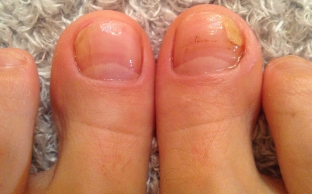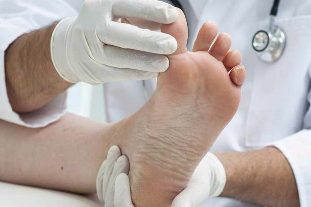Darkening of the nail plate, its thickening, delamination, and deformation can be an indication of the development of nail fungus (onychomycosis). Many patients confuse an infected injury, or psoriasis. In order to prevent the deterioration of the disease, you will need to know how to identify the fungus on the toe nail, its types and symptoms.
The type of nail fungus treatment

Most often, the fungal infection is spreading, and not just on the nail, and it affects about nail zone. Also, they suffer from the skin of the feet and interdigital folds, such as the hands and the feet (athlete's foot). Some of the most common pathogenic organisms that cause negative changes can be distinguished:
- the yeast – to hit a nail, which is a lighter weight, which leads to the delamination of the plate from the bed;
- dermatophytes – penetrates the stratum corneum, can lead to the occurrence of yellow bands or white spots, which will eventually increase;
- the fungus penetrates into the top of the layers panel and change the color to green, grey or black.
When the infection affects the nails, in the early stages, they are beginning to show the change, on the basis of which we can distinguish 3 main types of fungi.
- Distal onychomycosis. Defeat starts from the edge of the stratum corneum, and then the infection moves to the base of the plate. The nail becomes greyish, thickens, or thins out, crumble, and ultimately almost entirely destroyed.
- Proximal fungal. Extending from the center of the plate, which causes the darkening and destruction.
- Superficial onychomycosis. Accompanied by the emergence of white patches in the middle of the nail, or at its edges. In the early stages of the disease the panel does not have the volume, but it is at the touch of a noticeable looseness of, which will eventually lead to a change in the bed, and the loss of the nail.
The first signs and symptoms of nail fungus
The development of the fungus, so there are no hidden flows. A few days after the infection in the first signs and symptoms that will eventually become lighter.
- The nail grows dull, loses its luster, or change the pattern of the plates appear yellow or white spots, longitudinal stripes.
- Changing the shape of the nails, the deformation of which is accompanied by thickening or thinning of the stratum corneum. This situation can lead to delamination, attrition of the plate, and a further separate it from the bed.
- Of experiencing pain when. In the stratum corneum and in the surrounding tissue to become inflamed.
- Diaper rash between the toes, and the smell from the nail Polish.

These symptoms and signs can help to identify a nail fungus in its early stages and to distinguish it from other illnesses (bruises, psoriasis, eczema, lichen).
The diagnostic methods of the
The process of detection of onychomycosis or fungal infections are usually passed through several stages, which include the specific methods: the clinical picture, microscopy.
First, by focusing attention on the symptoms and complaints of the patient, collection of clinical data. After a review of the nail plate and the skin around them to the doctor prior to the identification of the infection, while excluding similar diseases (psoriasis, red shingles, and the problems with the normal diet of the nails).
For the confirmation of the disease by the specialist, makes a material to perform a microscopic examination. The affected area is necessary to scrape the tissue under laboratory conditions, is treated with a special substance.
A more precise diagnosis of a fungal property helps in the study of biological materials. The analysis was carried out using microscopy. The sowing is done by scraping. A sample of the affected tissue, which is placed in a nutrient for a fungus to the environment. After 3-5 days you can receive the results of the procedure. A type of fungus manages to learn the structure of the workshop, and their specific growth and colour.
Thank you for the life of the research to accurately determine the type of the virus and its sensitivity to specific antimicrobials. This allows you to not only identify the exact pathogen, but also to select an effective treatment.
How to identify nail fungus at home?
Darkening of the nail plate, its porosity, and the exhaustion of, it may not always indicate onychomycosis. If you want to find out whether a fungal infection can be the use of iodine and potassium permanganate.
Define onychomycosis by potassium permanganate
The procedure for the determination of the fungus may take a bit of time, and has an easy-to-use. In a basin of warm water, to dissolve some of the manganese, it would be a bad solution. Given the current arm or a leg, and wait for 5 to 10 minutes to complete. In the meantime, the healthy nail will be painted in a brown color to the affected areas, it will remain the same.
Definition of nail fungus with iodine
Unlike manganese, iodine, it may not indicate the presence of pathogens of onychomycosis. It helps to exclude other fungi, especially tinea versicolor. If the skin around the nails appeared to be peeling, redness, if such a zone has to be treated with iodine. For healthy skin it is nearly dark under the alcoholic solution is, however, relieve the affected places will be a rich, dark color.
How to distinguish a fungal infection of the nails of the other diseases?
In the early stages of the development of a fungal infection can be confused with skin diseases (psoriasis, shingles), or injury to the nail. It does not lead to the negative events, it is important that you know the main differences of the fungal growth.

- Darkening of the nail plate, the appearance of yellow spots and longitudinal streaks, which gradually become larger and penetrate deeper into the nail.
- The smooth progression of the disease without exacerbations and calm, as in the case of psoriasis. The fungus gradually deforms the nail plate, as long as its legal separation from the bed.
- The smell and the painful sensations, including different fungi, from damage to or the psoriatic lesions, eczema, lichen.
- Causes the fungus may be able to access the public area (pool, sauna), wearing tight shoes (microtrauma and increased), the increased sweating of the feet, diaper rash, and to contact with an infected person.
- The fungus appears first on one finger, and often significant, then the impact on the rest of the phalanges and interdigital areas.
These differences help to identify the fungus in the early stages of their development. The main thing is to understand that self-diagnosis is not enough. In order to effectively treat, you need a review on it.
Mycosis – a nasty and insidious disease that can masquerade as other diseases (psoriasis, eczema). It is important to monitor closely the nails and the feet, and when the suspicious symptoms in time to see a doctor for a timely treatment.






























